A Century of Water–Socioecological Dynamics and Evolutionary Stages in Lake Victoria Basin, East Africa
Abstract
:1. Introduction
2. Study Area and Methodology
2.1. Study Area
2.2. Methodology
3. Results
3.1. A Theoretical Analytical Framework for LVBW-SESs
3.2. Characterization of Changes in Key Elements of Water–Social Ecosystems in the Lake Victoria Basin in the Last 100 Years
3.3. Impacts of Climate Change on LVB Water System
3.4. Feedback Between Basin Land-Use Changes, Urbanization, and the Water Environment
| Wastes | Major Sources | Study Location | Reference |
|---|---|---|---|
| Heavy metals Pb, Cd, Cu, Zn, Cr | Emissions from industrial production, metallurgy, chemical industry, electroplating, and leather industry. | Industrial areas around Lake Victoria, such as Entebbe and Kampala (Uganda), Kisumu (Kenya), Musaka (Tanzania), and Kenyan River Basin Rivers and Sediment. | [95,96,97,98] |
| Fertilizers, pesticides in agriculture, urban sewage, and domestic waste. | Non-point agricultural operations, urban and rural settlements, rift valley lakes in Kenya, Mwanza Bay Wetlands (Tanzania). | [99,100,101,102] | |
| Hg, Cr | Emissions from gold mining and tanning industry. | Tanzania Gold Mining Area, Napoleon and Winam Gulfs, Kampala, and Kisumu. | [103,104,105] |
| Nutrient pollution Nitrogenous and Phosphorus contaminants | Agricultural runoff | Agricultural regions in Kenya, Uganda, and Tanzania. | [106] |
| Domestic sewage and industrial wastewater. | Kampala (Uganda), Kisumu (Kenya), and other cities along the lake. | [87,107,108] | |
| Lakeside Industry (Wastewater discharge from food processing, leather making, and chemical industries, especially phosphorus emissions). | Industrially concentrated areas such as Kampala, Entebbe, and Musaka. | [109,110] |
3.5. Relationship Between Water Ecological Degradation and Species Invasions
4. Discussion
4.1. Stages in the Evolution of LVB Water–Social Ecosystems in the Last 100 Years
4.2. Implications for Watershed Management
5. Conclusions
Author Contributions
Funding
Data Availability Statement
Conflicts of Interest
References
- Mosaffaie, J.; Salehpour Jam, A.; Tabatabaei, M.R.; Kousari, M.R. Trend Assessment of the Watershed Health Based on DPSIR Framework. Land Use Policy 2021, 100, 104911. [Google Scholar] [CrossRef]
- Vörösmarty, C.J.; Green, P.; Salisbury, J.; Lammers, R.B. Global Water Resources: Vulnerability from Climate Change and Population Growth. Science 2000, 289, 284–288. [Google Scholar] [CrossRef] [PubMed]
- Jun, X.; Chen, Y.D. Water Problems and Opportunities in the Hydrological Sciences in China. Hydrol. Sci. J. 2001, 46, 907–921. [Google Scholar] [CrossRef]
- Sivapalan, M.; Savenije, H.H.G.; Blöschl, G. Socio-hydrology: A New Science of People and Water. Hydrol. Process. 2012, 26, 1270–1276. [Google Scholar] [CrossRef]
- Vörösmarty, C.J.; Pahl-Wostl, C.; Bunn, S.E.; Lawford, R. Global Water, the Anthropocene and the Transformation of a Science. Curr. Opin. Environ. Sustain. 2013, 5, 539–550. [Google Scholar] [CrossRef]
- Ostrom, E. A General Framework for Analyzing Sustainability of Social-Ecological Systems. Science 2009, 325, 419–422. [Google Scholar] [CrossRef]
- Berkes, F.; Kislalioglu, M.; Folke, C.; Gadgil, M. Minireviews: Exploring the Basic Ecological Unit: Ecosystem-like Concepts in Traditional Societies. Ecosystems 1998, 1, 409–415. [Google Scholar] [CrossRef]
- Challies, E.; Newig, J.; Lenschow, A. What Role for Social–Ecological Systems Research in Governing Global Teleconnections? Glob. Environ. Chang. 2014, 27, 32–40. [Google Scholar] [CrossRef]
- Birkmann, J. Risk and Vulnerability Indicators at Different Scales: Applicability, Usefulness and Policy Implications. Environ. Hazards 2007, 7, 20–31. [Google Scholar] [CrossRef]
- Bolaños-Valencia, I.; Villegas-Palacio, C.; López-Gómez, C.P.; Berrouet, L.; Ruiz, A. Social Perception of Risk in Socio-Ecological Systems. A Qualitative and Quantitative Analysis. Ecosyst. Serv. 2019, 38, 100942. [Google Scholar] [CrossRef]
- Santana, S.E.; Barroso, G.F. Integrated Ecosystem Management of River Basins and the Coastal Zone in Brazil. Water Resour. Manag. 2014, 28, 4927–4942. [Google Scholar] [CrossRef]
- Elsawah, A.M.; Qin, H. Lower Bound of Centered L 2 -Discrepancy for Mixed Two and Three Levels U -Type Designs. J. Stat. Plan. Inference 2015, 161, 1–11. [Google Scholar] [CrossRef]
- Kanyuuru, C.K.; Mburu, J.; Njoka, J. Adaptation of Institutional Arrangements to Management of Northern Rangelands of Kenya. Environ. Dev. Sustain. 2017, 19, 67–82. [Google Scholar] [CrossRef]
- Mayer, A.; Winkler, R.; Fry, L. Classification of Watersheds into Integrated Social and Biophysical Indicators with Clustering Analysis. Ecol. Indic. 2014, 45, 340–349. [Google Scholar] [CrossRef]
- Mahabadi, S.A.; Bavani, A.R.M.; Bgheri, A. Improving Adaptive Capacity of Social-Ecological System of Tashk-Bakhtegan Lake Basin to Climate Change Effects—A Methodology Based on Post-Modern Portfolio Theory. Ecohydrol. Hydrobiol. 2018, 18, 365–378. [Google Scholar] [CrossRef]
- Kalantari, Z.; Santos Ferreira, C.S.; Page, J.; Goldenberg, R.; Olsson, J.; Destouni, G. Meeting Sustainable Development Challenges in Growing Cities: Coupled Social-Ecological Systems Modeling of Land Use and Water Changes. J. Environ. Manag. 2019, 245, 471–480. [Google Scholar] [CrossRef] [PubMed]
- Yu, G.; Li, M.; Tu, Z.; Yu, Q.; Jie, Y.; Xu, L.; Dang, Y.; Chen, X. Conjugated Evolution of Regional Social-Ecological System Driven by Land Use and Land Cover Change. Ecol. Indic. 2018, 89, 213–226. [Google Scholar] [CrossRef]
- Cabello, V.; Willaarts, B.A.; Aguilar, M.; Del Moral Ituarte, L. River Basins as Social-Ecological Systems: Linking Levels of Societal and Ecosystem Water Metabolism in a Semiarid Watershed. Ecol. Soc. 2015, 20, 20. [Google Scholar] [CrossRef]
- Lufafa, A.; Tenywa, M.M.; Isabirye, M.; Majaliwa, M.J.G.; Woomer, P.L. Prediction of Soil Erosion in a Lake Victoria Basin Catchment Using a GIS-Based Universal Soil Loss Model. Agric. Syst. 2003, 76, 883–894. [Google Scholar] [CrossRef]
- Olaka, L.A.; Odada, E.O.; Trauth, M.H.; Olago, D.O. The Sensitivity of East African Rift Lakes to Climate Fluctuations. J. Paleolimnol. 2010, 44, 629–644. [Google Scholar] [CrossRef]
- Adger, W.N.; Vincent, K. Uncertainty in Adaptive Capacity. Comptes Rendus Géosci. 2005, 337, 399–410. [Google Scholar] [CrossRef]
- Castro, J.E. Water Governance in the Twentieth-First Century. Ambient. Soc. 2007, 10, 97–118. [Google Scholar] [CrossRef]
- Dobiesz, N.E.; Hecky, R.E.; Johnson, T.B.; Sarvala, J.; Dettmers, J.M.; Lehtiniemi, M.; Rudstam, L.G.; Madenjian, C.P.; Witte, F. Metrics of Ecosystem Status for Large Aquatic Systems—A Global Comparison. J. Gt. Lakes Res. 2010, 36, 123–138. [Google Scholar] [CrossRef]
- Awange, J.L.; Saleem, A.; Sukhadiya, R.M.; Ouma, Y.O.; Kexiang, H. Physical Dynamics of Lake Victoria over the Past 34 Years (1984–2018): Is the Lake Dying? Sci. Total Environ. 2019, 658, 199–218. [Google Scholar] [CrossRef] [PubMed]
- Njiru, M.; Mkumbo, O.C.; van der Knaap, M. Some Possible Factors Leading to Decline in Fish Species in Lake Victoria. Aquat. Ecosyst. Health Manag. 2010, 13, 3–10. [Google Scholar] [CrossRef]
- Kizza, M.; Rodhe, A.; Xu, C.-Y.; Ntale, H.K.; Halldin, S. Temporal Rainfall Variability in the Lake Victoria Basin in East Africa during the Twentieth Century. Theor. Appl. Climatol. 2009, 98, 119–135. [Google Scholar] [CrossRef]
- Awange, J.L.; Sharifi, M.A.; Ogonda, G.; Wickert, J.; Grafarend, E.W.; Omulo, M.A. The Falling Lake Victoria Water Level: GRACE, TRIMM and CHAMP Satellite Analysis of the Lake Basin. Water Resour. Manag. 2008, 22, 775–796. [Google Scholar] [CrossRef]
- Kizza, M.; Westerberg, I.; Rodhe, A.; Ntale, H.K. Estimating Areal Rainfall over Lake Victoria and Its Basin Using Ground-Based and Satellite Data. J. Hydrol. 2012, 464–465, 401–411. [Google Scholar] [CrossRef]
- Nicholson, S.E. Climate and Climatic Variability of Rainfall over Eastern Africa. Rev. Geophys. 2017, 55, 590–635. [Google Scholar] [CrossRef]
- Song, Y.; Semazzi, F.H.M.; Xie, L.; Ogallo, L.J. A Coupled Regional Climate Model for the Lake Victoria Basin of East Africa. Int. J. Climatol. 2004, 24, 57–75. [Google Scholar] [CrossRef]
- Olokotum, M.; Mitroi, V.; Troussellier, M.; Semyalo, R.; Bernard, C.; Montuelle, B.; Okello, W.; Quiblier, C.; Humbert, J.-F. A Review of the Socioecological Causes and Consequences of Cyanobacterial Blooms in Lake Victoria. Harmful Algae 2020, 96, 101829. [Google Scholar] [CrossRef] [PubMed]
- Prodanovic, P.; Simonovic, S.P. An Operational Model for Support of Integrated Watershed Management. Water Resour. Manag. 2010, 24, 1161–1194. [Google Scholar] [CrossRef]
- Pietroiusti, R.; Vanderkelen, I.; Otto, F.E.L.; Barnes, C.; Temple, L.; Akurut, M.; Bally, P.; Van Lipzig, N.P.M.; Thiery, W. Possible Role of Anthropogenic Climate Change in the Record-Breaking 2020 Lake Victoria Levels and Floods. Earth Syst. Dyn. 2024, 15, 225–264. [Google Scholar] [CrossRef]
- Wang, X.; Shi, K.; Qin, B.; Zhang, Y.; Woolway, R.I. Disproportionate Impact of Atmospheric Heat Events on Lake Surface Water Temperature Increases. Nat. Clim. Chang. 2024, 14, 1172–1177. [Google Scholar] [CrossRef]
- Wu, G.; Chen, C.; Liu, Y.; Fan, X.; Niu, H.; Liu, Y. Developing a High-Resolution Seamless Surface Water Extent Time-Series over Lake Victoria by Integrating MODIS and Landsat Data. Remote Sens. 2023, 15, 3500. [Google Scholar] [CrossRef]
- Ma, J.; Loiselle, S.; Cao, Z.; Qi, T.; Shen, M.; Luo, J.; Song, K.; Duan, H. Unbalanced Impacts of Nature and Nurture Factors on the Phenology, Area and Intensity of Algal Blooms in Global Large Lakes: MODIS Observations. Sci. Total Environ. 2023, 880, 163376. [Google Scholar] [CrossRef]
- Funk, C.; Peterson, P.; Landsfeld, M.; Pedreros, D.; Verdin, J.; Shukla, S.; Husak, G.; Rowland, J.; Harrison, L.; Hoell, A.; et al. The Climate Hazards Infrared Precipitation with Stations—A New Environmental Record for Monitoring Extremes. Sci Data 2015, 2, 150066. [Google Scholar] [CrossRef]
- World Population Prospects. Available online: https://population.un.org/wpp/ (accessed on 4 March 2025).
- Open Spatial Demographic Data and Research. Available online: https://www.worldpop.org/ (accessed on 4 March 2025).
- United Nations. 2018 Revision of World Urbanization Prospects. Available online: https://www.un.org/en/desa/2018-revision-world-urbanization-prospects (accessed on 4 March 2025).
- Zhang, X.; Liu, L.; Chen, X.; Gao, Y.; Xie, S.; Mi, J. GLC_FCS30: Global Land-Cover Product with Fine Classification System at 30 m Using Time-Series Landsat Imagery. Earth Syst. Sci. Data 2021, 13, 2753–2776. [Google Scholar] [CrossRef]
- McGinnis, M.D.; Ostrom, E. Social-Ecological System Framework: Initial Changes and Continuing Challenges. Ecol. Soc. 2014, 19, 30. [Google Scholar] [CrossRef]
- Shahin, M.M.A. Hydrology of the Nile Basin; Elsevier: Amsterdam, The Netherlands, 1985; ISBN 978-0-08-088756-2. [Google Scholar]
- Lemoalle, J.; Bader, J.-C.; Leblanc, M.; Sedick, A. Recent Changes in Lake Chad: Observations, Simulations and Management Options (1973–2011). Glob. Planet. Chang. 2012, 80–81, 247–254. [Google Scholar] [CrossRef]
- Pavur, G.; Lakshmi, V. Observing the Recent Floods and Drought in the Lake Victoria Basin Using Earth Observations and Hydrological Anomalies. J. Hydrol. Reg. Stud. 2023, 46, 101347. [Google Scholar] [CrossRef]
- Wasige, J.E.; Groen, T.A.; Smaling, E.; Jetten, V. Monitoring Basin-Scale Land Cover Changes in Kagera Basin of Lake Victoria Using Ancillary Data and Remote Sensing. Int. J. Appl. Earth Obs. Geoinf. 2013, 21, 32–42. [Google Scholar] [CrossRef]
- Nyeko-Ogiramoi, P. Trend and Variability in Observed Hydrometeorological Extremes in the Lake Victoria Basin. J. Hydrol. 2013, 489, 56–73. [Google Scholar] [CrossRef]
- Getirana, A.; Jung, H.C.; Van Den Hoek, J.; Ndehedehe, C.E. Hydropower Dam Operation Strongly Controls Lake Victoria’s Freshwater Storage Variability. Sci. Total Environ. 2020, 726, 138343. [Google Scholar] [CrossRef] [PubMed]
- Umwali, E.D.; Chen, X.; Ma, X.; Guo, Z.; Mbigi, D.; Zhang, Z.; Umugwaneza, A.; Gasirabo, A.; Umuhoza, J. Integrated SSP-RCP Scenarios for Modeling the Impacts of Climate Change and Land Use on Ecosystem Services in East Africa. Ecol. Model. 2025, 504, 111092. [Google Scholar] [CrossRef]
- Piper, B.S.; Plinston, D.T.; Sutcliffe, J.V. The Water Balance of Lake Victoria. Hydrol. Sci. J. 1986, 31, 25–37. [Google Scholar] [CrossRef]
- Sewagudde, S. Lake Victoria’s Water Budget and the Potential Effects of Climate Change in the 21st Century. Afr. J. Trop. Hydrobiol. Fish. 2009, 12, 22–30. [Google Scholar] [CrossRef]
- Mistry, V.V.; Conway, D. Remote Forcing of East African Rainfall and Relationships with Fluctuations in Levels of Lake Victoria. Int. J. Climatol. 2003, 23, 67–89. [Google Scholar] [CrossRef]
- Sene, K.; Houghton Carr, H.; Tych, W. Reflections on Almost a Century of Hydrological Studies on Africa’s Largest Lake. Proc. Int. Assoc. Hydrol. Sci. 2021, 384, 141–147. [Google Scholar] [CrossRef]
- Omondi, P.; Awange, J.L.; Ogallo, L.A.; Okoola, R.A.; Forootan, E. Decadal Rainfall Variability Modes in Observed Rainfall Records over East Africa and Their Relations to Historical Sea Surface Temperature Changes. J. Hydrol. 2012, 464–465, 140–156. [Google Scholar] [CrossRef]
- Omondi, P.; Awange, J.L.; Ogallo, L.A.; Ininda, J.; Forootan, E. The Influence of Low Frequency Sea Surface Temperature Modes on Delineated Decadal Rainfall Zones in Eastern Africa Region. Adv. Water Resour. 2013, 54, 161–180. [Google Scholar] [CrossRef]
- Muyodi, F.J.; Bugenyi, F.W.B.; Hecky, R.E. Experiences and Lessons Learned from Interventions in the Lake Victoria Basin: The Lake Victoria Environmental Management Project. Lakes Reserv. Sci. Policy Manag. Sustain. Use 2010, 15, 77–88. [Google Scholar] [CrossRef]
- Kite, G.W. Recent Changes in Level of Lake Victoria / Récents Changements Enregistrés Dans Le Niveau Du Lac Victoria. Hydrol. Sci. Bull. 1981, 26, 233–243. [Google Scholar] [CrossRef]
- Anyah, R.O.; Semazzi, F.H.M. Variability of East African Rainfall Based on Multiyear Regcm3 Simulations. Int. J. Climatol. 2007, 27, 357–371. [Google Scholar] [CrossRef]
- Shinhu, R.J.; Amasi, A.I.; Wynants, M.; Nobert, J.; Mtei, K.M.; Njau, K.N. Assessing the Impacts of Land Use and Climate Changes on River Discharge towards Lake Victoria. Earth 2023, 4, 365–383. [Google Scholar] [CrossRef]
- Vanderkelen, I.; Van Lipzig, N.P.M.; Thiery, W. Modelling the Water Balance of Lake Victoria (East Africa)—Part 2: Future Projections. Hydrol. Earth Syst. Sci. 2018, 22, 5527–5549. [Google Scholar] [CrossRef]
- Awange, J.L.; Anyah, R.; Agola, N.; Forootan, E.; Omondi, P. Potential Impacts of Climate and Environmental Change on the Stored Water of Lake Victoria Basin and Economic Implications: Impacts of Climate Change on Waters of Lake Victoria. Water Resour. Res. 2013, 49, 8160–8173. [Google Scholar] [CrossRef]
- Awange, J. Lake Victoria Monitored from Space; Springer International Publishing: Cham, Switzerland, 2021; ISBN 978-3-030-60550-6. [Google Scholar]
- Marshall, B.; Ezekiel, C.; Gichuki, J.; Mkumbo, O.; Sitoki, L.; Wanda, F. Global Warming Is Reducing Thermal Stability and Mitigating the Effects of Eutrophication in Lake Victoria (East Africa). Nat. Preced. 2009. [Google Scholar] [CrossRef]
- Coughlan De Perez, E.; Van Aalst, M.; Choularton, R.; Van Den Hurk, B.; Mason, S.; Nissan, H.; Schwager, S. From Rain to Famine: Assessing the Utility of Rainfall Observations and Seasonal Forecasts to Anticipate Food Insecurity in East Africa. Food Sec. 2019, 11, 57–68. [Google Scholar] [CrossRef]
- Kansiime, F.; Saunders, M.J.; Loiselle, S.A. Functioning and Dynamics of Wetland Vegetation of Lake Victoria: An Overview. Wetl. Ecol. Manag. 2007, 15, 443–451. [Google Scholar] [CrossRef]
- Lung’ayia, H.; Sitoki, L.; Kenyanya, M. The Nutrient Enrichment of Lake Victoria (Kenyan Waters). Hydrobiologia 2001, 458, 75–82. [Google Scholar] [CrossRef]
- Kiwango, Y.A.; Wolanski, E. Papyrus Wetlands, Nutrients Balance, Fisheries Collapse, Food Security, and Lake Victoria Level Decline in 2000–2006. Wetl. Ecol. Manag. 2008, 16, 89–96. [Google Scholar] [CrossRef]
- Witte, F.; Silsbe, G.M.; Hecky, R.E.; Goudswaard, P.C.; Guildford, S.J.; Kishe-Machumu, M.A.; Wanink, J.H. Did the Loss of Phytoplanktivorous Fish Contribute to Algal Blooms in the Mwanza Gulf of Lake Victoria? Hydrobiologia 2012, 679, 283–296. [Google Scholar] [CrossRef]
- Cornelissen, I.J.M.; Silsbe, G.M.; Verreth, J.A.J.; Van Donk, E.; Nagelkerke, L.A.J. Dynamics and Limitations of Phytoplankton Biomass along a Gradient in Mwanza Gulf, Southern Lake Victoria (Tanzania). Freshw. Biol. 2014, 59, 127–141. [Google Scholar] [CrossRef]
- Kabenge, M.; Wang, H.; Li, F. Urban Eutrophication and Its Spurring Conditions in the Murchison Bay of Lake Victoria. Environ. Sci. Pollut. Res. 2016, 23, 234–241. [Google Scholar] [CrossRef]
- Wang, H.; Wang, T.; Toure, B.; Li, F. Protect Lake Victoria through Green Economy, Public Participation and Good Governance. Environ. Sci. Technol. 2012, 46, 10483–10484. [Google Scholar] [CrossRef] [PubMed]
- Njagi, D.M.; Routh, J.; Odhiambo, M.; Luo, C.; Basapuram, L.G.; Olago, D.; Klump, V.; Stager, C. A Century of Human-Induced Environmental Changes and the Combined Roles of Nutrients and Land Use in Lake Victoria Catchment on Eutrophication. Sci. Total Environ. 2022, 835, 155425. [Google Scholar] [CrossRef] [PubMed]
- Hecky, R.E. The Eutrophication of Lake Victoria. SIL Proc. 1922–2010 1993, 25, 39–48. [Google Scholar] [CrossRef]
- Hecky, R.E.; Mugidde, R.; Ramlal, P.S.; Talbot, M.R.; Kling, G.W. Multiple Stressors Cause Rapid Ecosystem Change in Lake Victoria. Freshw. Biol. 2010, 55, 19–42. [Google Scholar] [CrossRef]
- Maitima, J.M.; Olson, J.M.; Mugatha, S.M.; Mugisha, S.; Mutie, I.T. Land Use Changes, Impacts and Options for Sustaining Productivity and Livelihoods in the Basin of Lake Victoria. J. Sustain. Dev. Afr. 2010, 12, 1520–5509. [Google Scholar]
- Owiyo, P. The Effect of Dominion Irrigation Project on Environmental Conservation in Yala Swamp, Siaya District, Kenya. Int. J. Sci. Res. 2012, 3, SEP14549. [Google Scholar]
- Shadle, B.L. Rape in the Courts of Gusiiland, Kenya, 1940s–1960s. Afr. Stud. Rev. 2008, 51, 27–50. [Google Scholar] [CrossRef]
- Sondou, T.; Aholou, C.C.; Chenal, J. Territorial Coherence Through Urban Planning, Myth or Reality: Analysis of Planning Instruments in Ho (Ghana) and Kpalimé (Togo). Land 2025, 14, 81. [Google Scholar] [CrossRef]
- Mugo, J.N.; Karanja, N.N.; Gachene, C.K.; Dittert, K.; Nyawade, S.O.; Schulte-Geldermann, E. Assessment of Soil Fertility and Potato Crop Nutrient Status in Central and Eastern Highlands of Kenya. Sci. Rep. 2020, 10, 7779. [Google Scholar] [CrossRef] [PubMed]
- Food and Agriculture Organization of the United Nations. The State of Food and Agriculture 2015: Social Protection and Agriculture—Breaking the Cycle of Rural Poverty; The State of Food and Agriculture; UN: New York, NY, USA, 2015; ISBN 978-92-1-047314-9. [Google Scholar]
- Bullock, E.L.; Healey, S.P.; Yang, Z.; Oduor, P.; Gorelick, N.; Omondi, S.; Ouko, E.; Cohen, W.B. Three Decades of Land Cover Change in East Africa. Land 2021, 10, 150. [Google Scholar] [CrossRef]
- Jayne, T.S.; Chamberlin, J.; Headey, D.D. Land Pressures, the Evolution of Farming Systems, and Development Strategies in Africa: A Synthesis. Food Policy 2014, 48, 1–17. [Google Scholar] [CrossRef]
- Gidey, E.; Mhangara, P. An Application of Machine-Learning Model for Analyzing the Impact of Land-Use Change on Surface Water Resources in Gauteng Province, South Africa. Remote Sens. 2023, 15, 4092. [Google Scholar] [CrossRef]
- Matagi, S.V. Some Issues of Environmental Concern in Kampala, the Capital City of Uganda. Environ. Monit. Assess. 2002, 77, 121–138. [Google Scholar] [CrossRef]
- Ngupula, G.; Ezekiel, C.; Kimirei, I.; Mboni, E.; Kashindye, B. Physical and Chemical Characteristics of the Tanzanian Inshore and Offshore Waters of Lake Victoria in 2005–2008. Afr. J. Aquat. Sci. 2012, 37, 339–345. [Google Scholar] [CrossRef]
- Twesigye, C.K. The Impact of Land Use Activities on Vegetation Cover and Water Quality in the Lake Victoria Watershed. Open Environ. Eng. J. 2011, 4, 66–77. [Google Scholar] [CrossRef]
- Verschuren, D.; Johnson, T.C.; Kling, H.J.; Edgington, D.N.; Leavitt, P.R.; Brown, E.T.; Talbot, M.R.; Hecky, R.E. History and Timing of Human Impact on Lake Victoria, East Africa. Proc. Biol. Sci. 2002, 269, 289–294. [Google Scholar] [CrossRef] [PubMed]
- Ntiba, M.J.; Kudoja, W.M.; Mukasa, C.T. Management Issues in the Lake Victoria Watershed. Lakes Reserv. Sci. Policy Manag. Sustain. Use 2001, 6, 211–216. [Google Scholar] [CrossRef]
- Haande, S.; Rohrlack, T.; Semyalo, R.P.; Brettum, P.; Edvardsen, B.; Lyche-Solheim, A.; Sørensen, K.; Larsson, P. Phytoplankton Dynamics and Cyanobacterial Dominance in Murchison Bay of Lake Victoria (Uganda) in Relation to Environmental Conditions. Limnologica 2011, 41, 20–29. [Google Scholar] [CrossRef]
- Sitoki, L.; Kurmayer, R.; Rott, E. Spatial Variation of Phytoplankton Composition, Biovolume, and Resulting Microcystin Concentrations in the Nyanza Gulf (Lake Victoria, Kenya). Hydrobiologia 2012, 691, 109–122. [Google Scholar] [CrossRef]
- Tsamo, C.; Meali, D.S.; Assaouka, H.T. Studying the Impact of Anions Pre-Generated Iron Corrosion Products on the Efficiency of Contaminant Removal in Fe0/H2O Systems. J. Environ. Sci. Eng. B 2018, 7, 1–10. [Google Scholar] [CrossRef]
- Blakime, T.-H.; Adjonou, K.; Komi, K.; Hlovor, A.K.D.; Gbafa, K.S.; Zoungrana, J.-B.B.; Polorigni, B.; Kokou, K. Dynamics of Built-Up Areas and Challenges of Planning and Development of Urban Zone of Greater Lomé in Togo, West Africa. Land 2024, 13, 84. [Google Scholar] [CrossRef]
- Nakawuka, P.; Langan, S.; Schmitter, P.; Barron, J. A Review of Trends, Constraints and Opportunities of Smallholder Irrigation in East Africa. Glob. Food Secur. 2018, 17, 196–212. [Google Scholar] [CrossRef]
- Berthet, E.T.; Bretagnolle, V.; Gaba, S. Place-Based Social-Ecological Research Is Crucial for Designing Collective Management of Ecosystem Services. Ecosyst. Serv. 2022, 55, 101426. [Google Scholar] [CrossRef]
- Onyari, J.M.; Wandiga, S.O. Distribution of Cr, Pb, Cd, Zn, Fe and Mn in Lake Victoria Sediments, East Africa. Bull. Environ. Contam. Toxicol. 1989, 42, 807–813. [Google Scholar] [CrossRef]
- Scheren, P.A.G.M.; Bosboom, J.C.; Njau, K.K.; Lemmens, A.M.C. Assessment of Water Pollution in the Catchment Area of Lake Victoria, Tanzania. J. East. Afr. Res. Dev. 1995, 25, 129–143. [Google Scholar]
- Muwanga, A.; Barifaijo, E. Impact of Industrial Activities on Heavy Metal Loading and Their Physico-Chemical Effects on Wetlands of Lake Victoria Basin (Uganda). Afr. J. Sci. Technol. 2010, 7. [Google Scholar] [CrossRef]
- Shen, Q.; Friese, K.; Gao, Q.; Kimirei, I.A.; Kishe, M.A.; Chen, C.; Zhang, L.; Yu, C.; Wu, G.; Liu, Y. Accumulation Characteristics and Ecological Implications of Heavy Metals in Surface Sediments of the Mwanza Gulf, Lake Victoria. Environ. Monit. Assess. 2022, 194, 756. [Google Scholar] [CrossRef]
- Makundi, I.N. A Study of Heavy Metal Pollution in Lake Victoria Sediments by Energy Dispersive X-Ray Fluorescence. J. Environ. Sci. Health Part A 2001, 36, 909–921. [Google Scholar] [CrossRef]
- Lalah, J.O.; Ochieng, E.Z.; Wandiga, S.O. Sources of Heavy Metal Input into Winam Gulf, Kenya. Bull. Environ. Contam. Toxicol. 2008, 81, 277–284. [Google Scholar] [CrossRef] [PubMed]
- Ochieng, E.Z.; Lalah, J.O.; Wandiga, S.O. Analysis of Heavy Metals in Water and Surface Sediment in Five Rift Valley Lakes in Kenya for Assessment of Recent Increase in Anthropogenic Activities. Bull. Environ. Contam. Toxicol. 2007, 79, 570–576. [Google Scholar] [CrossRef] [PubMed]
- Machiwa, J. Nature of Suspended Particulate Matter and Concentrations of Heavy Metals in Sediment in the Southern Part of Lake Victoria, East Africa. Afr. J. Aquat. Sci. 2010, 35, 95–101. [Google Scholar] [CrossRef]
- Ikingura, J.R.; Akagi, H. Monitoring of Fish and Human Exposure to Mercury Due to Gold Mining in the Lake Victoria Goldfields, Tanzania. Sci. Total Environ. 1996, 191, 59–68. [Google Scholar] [CrossRef]
- Campbell, L.M.; Hecky, R.E.; Nyaundi, J.; Muggide, R.; George Dixon, D. Distribution and Food-Web Transfer of Mercury in Napoleon and Winam Gulfs, Lake Victoria, East Africa. J. Gt. Lakes Res. 2003, 29, 267–282. [Google Scholar] [CrossRef]
- Ochieng, E.Z.; Lalah, J.O.; Wandiga, S.O. Heavy Metals in Water and Surface Sediments in Winam Gulf of Lake Victoria, Kenya. Bull. Environ. Contam. Toxicol. 2006, 77, 459–468. [Google Scholar] [CrossRef]
- Nyenje, P.M.; Foppen, J.W.; Uhlenbrook, S.; Kulabako, R.; Muwanga, A. Eutrophication and Nutrient Release in Urban Areas of Sub-Saharan Africa—A Review. Sci. Total Environ. 2010, 408, 447–455. [Google Scholar] [CrossRef]
- Bakyayita, G.K.; Norrström, A.C.; Kulabako, R.N. Assessment of Levels, Speciation, and Toxicity of Trace Metal Contaminants in Selected Shallow Groundwater Sources, Surface Runoff, Wastewater, and Surface Water from Designated Streams in Lake Victoria Basin, Uganda. J. Environ. Public Health 2019, 2019, 6734017. [Google Scholar] [CrossRef] [PubMed]
- Oguttu, H.W.; Bugenyi, F.W.; Leuenberger, H.; Wolf, M.; Bachofen, R. Pollution Menacing Lake Victoria. Water SA 2008, 34, 89–98. [Google Scholar] [CrossRef]
- Kitaka, N.; Harper, D.M.; Mavuti, K.M. Phosphorus Inputs to Lake Naivasha, Kenya, from Its Catchment and the Trophic State of the Lake. In Lake Naivasha, Kenya: Papers Submitted by Participants at the Conference “Science and the Sustainable Management of Shallow Tropical Waters” Held at Kenya Wildlife Services Training Institute, Naivasha, Kenya, 11–16 April 1999 Together with Those from Additional Studies on the Lake; Harper, D.M., Boar, R.R., Everard, M., Hickley, P., Eds.; Springer: Dordrecht, The Netherlands, 2002; pp. 73–80. ISBN 978-94-017-2031-1. [Google Scholar]
- Odada, E.O.; Olago, D.O.; Kulindwa, K.; Ntiba, M.; Wandiga, S. Mitigation of Environmental Problems in Lake Victoria, East Africa: Causal Chain and Policy Options Analyses. Ambio 2004, 33, 13–23. [Google Scholar] [CrossRef]
- Lung’Ayia, H.B.O.; M’Harzi, A.; Tackx, M.; Gichuki, J.; Symoens, J.J. Phytoplankton Community Structure and Environment in the Kenyan Waters of Lake Victoria. Freshw. Biol. 2000, 43, 529–543. [Google Scholar] [CrossRef]
- Juma, D.W.; Wang, H.; Li, F. Impacts of Population Growth and Economic Development on Water Quality of a Lake: Case Study of Lake Victoria Kenya Water. Environ. Sci. Pollut. Res. 2014, 21, 5737–5746. [Google Scholar] [CrossRef]
- Barel, C.D.N.; Dorit, R.; Greenwood, P.H.; Fryer, G.; Hughes, N.; Jackson, P.B.N.; Kawanabe, H.; Lowe-McConnell, R.H.; Nagoshi, M.; Ribbink, A.J.; et al. Destruction of Fisheries in Africa’s Lakes. Nature 1985, 315, 19–20. [Google Scholar] [CrossRef]
- Ogutu-Ohwayo, R. The Decline of the Native Fishes of Lakes Victoria and Kyoga (East Africa) and the Impact of Introduced Species, Especially the Nile Perch, Lates niloticus, and the Nile Tilapia, Oreochromis niloticus. Environ. Biol. Fishes 1990, 27, 81–96. [Google Scholar] [CrossRef]
- Mailu, A.M. Preliminary Assessment of the Social, Economic and Environmental Impacts of Water Hyacinth in the Lake Victoria Basin and the Status of Control. In Biological and Integrated Control of Water Hyacinth, Eichhornia crassipes, Proceedings of the Second Meeting of the Global Working Group for the Biological and Integrated Control of Water Hyacinth, Beijing, China, 9–12 October 2000; Australian Centre for International Agricultural Research: Canberra, Australia, 2001. [Google Scholar]
- Wanda, F.; Namukose, M.; Matuha, M. Water Hyacinth Hotspots in the Ugandan Waters of Lake Victoria in 1994–2012: Implications for Management. Afr. J. Aquat. Sci. 2015, 40, 101–106. [Google Scholar] [CrossRef]
- Wu, X.; Wei, Y.; Fu, B.; Wang, S.; Zhao, Y.; Moran, E.F. Evolution and Effects of the Social-Ecological System over a Millennium in China’s Loess Plateau. Sci. Adv. 2020, 6, eabc0276. [Google Scholar] [CrossRef]
- Jaramillo, J.; Setamou, M.; Muchugu, E.; Chabi-Olaye, A.; Jaramillo, A.; Mukabana, J.; Maina, J.; Gathara, S.; Borgemeister, C. Climate Change or Urbanization? Impacts on a Traditional Coffee Production System in East Africa over the Last 80 Years. PLoS ONE 2013, 8, e51815. [Google Scholar] [CrossRef]
- Nunan, F. The Political Economy of Fisheries Co-Management: Challenging the Potential for Success on Lake Victoria. Glob. Environ. Chang. 2020, 63, 102101. [Google Scholar] [CrossRef]
- Mamboleo, M.; Lukhabi, D.K.; Mwenga, M.; Lomodei, E. Lake Victoria. In Aquatic Biomes; Elsevier: Amsterdam, The Netherlands, 2025; pp. 169–182. ISBN 978-0-443-15726-4. [Google Scholar]
- Nyamweya, C.; Lawrence, T.J.; Ajode, M.Z.; Smith, S.; Achieng, A.O.; Barasa, J.E.; Masese, F.O.; Taabu-Munyaho, A.; Mahongo, S.; Kayanda, R.; et al. Lake Victoria: Overview of Research Needs and the Way Forward. J. Gt. Lakes Res. 2023, 49, 102211. [Google Scholar] [CrossRef]
- Kong, X.; He, Q.; Yang, B.; He, W.; Xu, F.; Janssen, A.B.G.; Kuiper, J.J.; Van Gerven, L.P.A.; Qin, N.; Jiang, Y.; et al. Hydrological Regulation Drives Regime Shifts: Evidence from Paleolimnology and Ecosystem Modeling of a Large Shallow Chinese Lake. Glob. Chang. Biol. 2017, 23, 737–754. [Google Scholar] [CrossRef] [PubMed]
- Lin, Q.; Zhang, K.; Shen, J.; Liu, E. Integrating Long-Term Dynamics of Ecosystem Services into Restoration and Management of Large Shallow Lakes. Sci. Total Environ. 2019, 671, 66–75. [Google Scholar] [CrossRef]
- Qin, B.; Paerl, H.W.; Brookes, J.D.; Liu, J.; Jeppesen, E.; Zhu, G.; Zhang, Y.; Xu, H.; Shi, K.; Deng, J. Why Lake Taihu Continues to Be Plagued with Cyanobacterial Blooms through 10 Years (2007–2017) Efforts. Sci. Bull. 2019, 64, 354–356. [Google Scholar] [CrossRef]
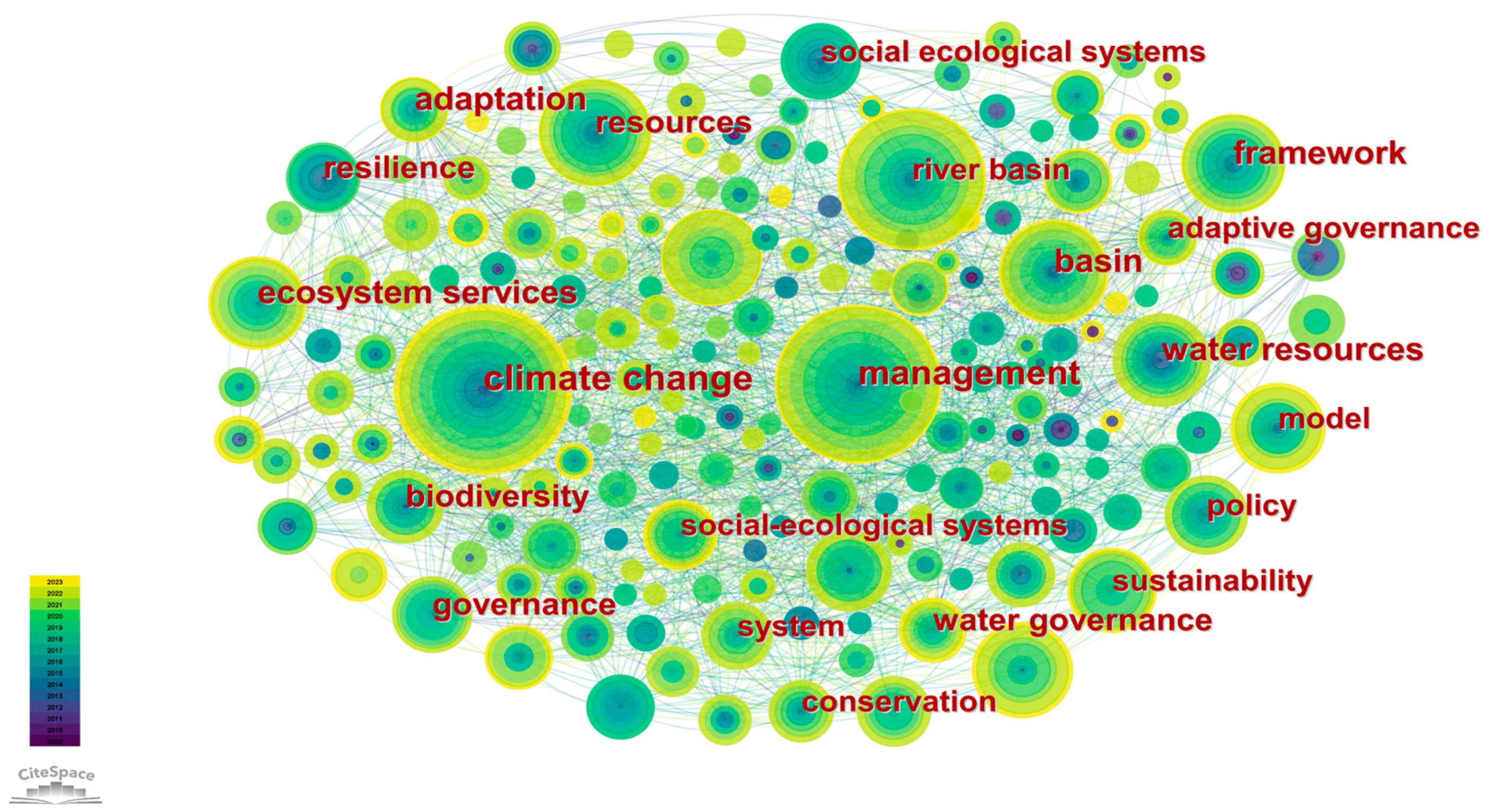
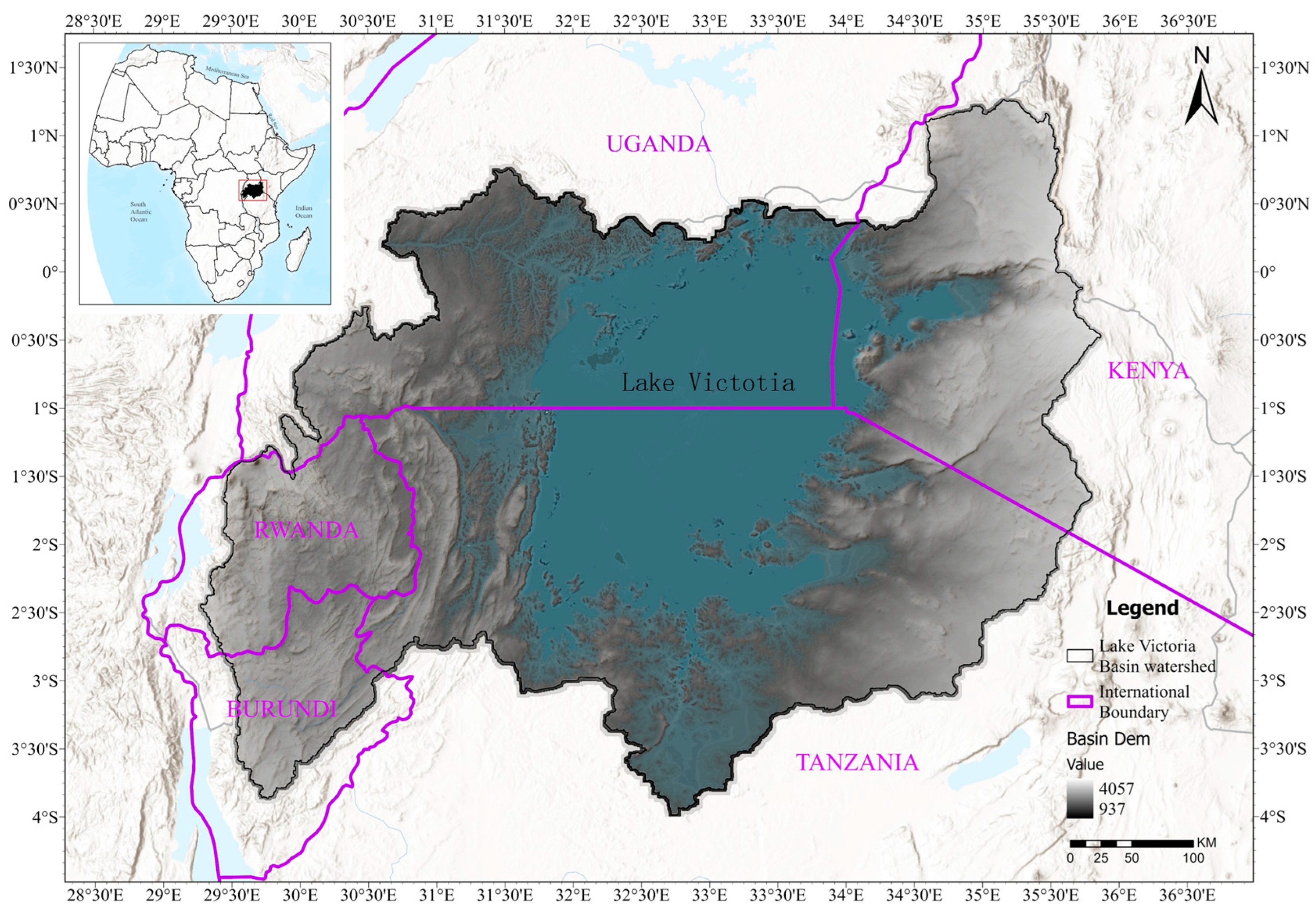
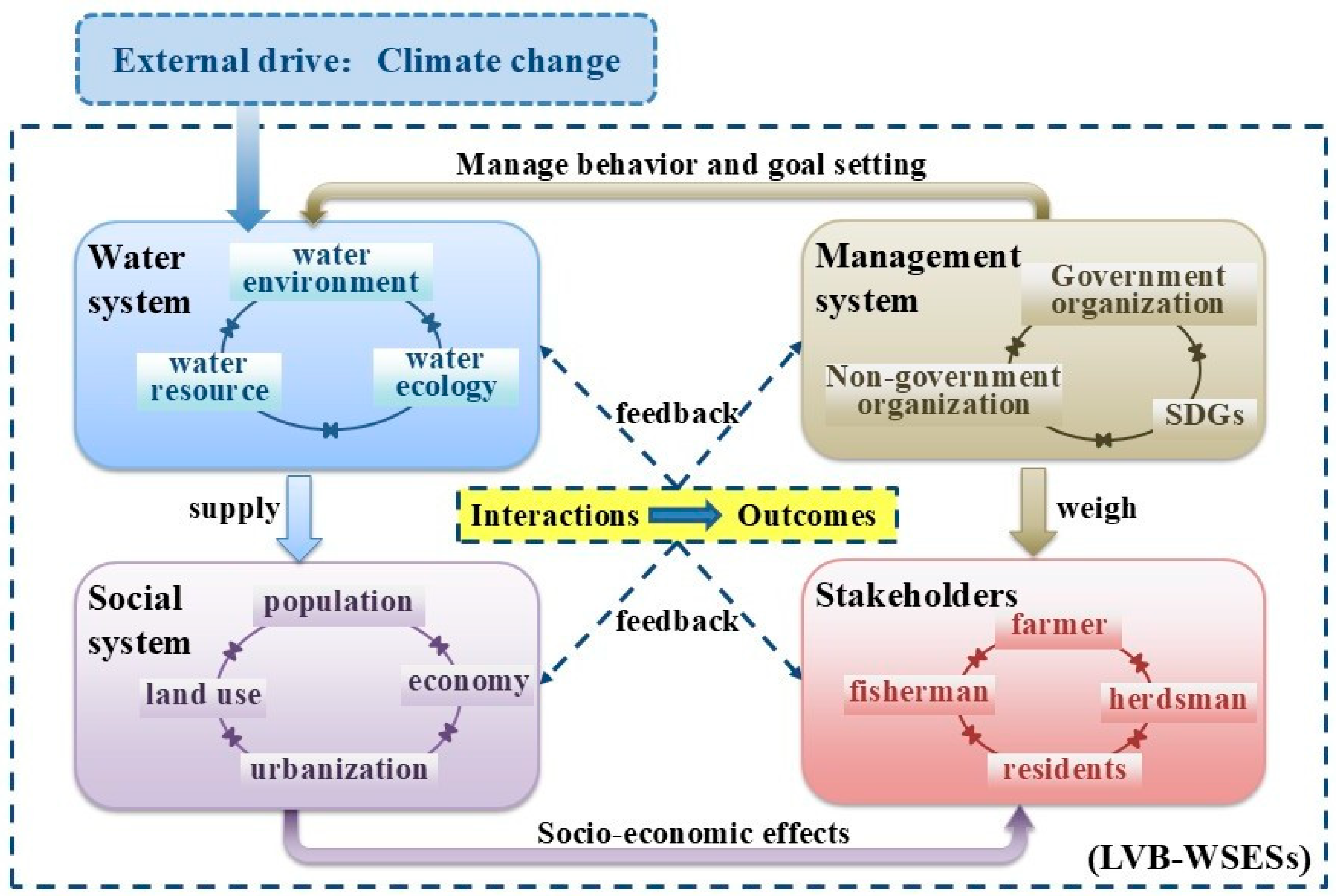
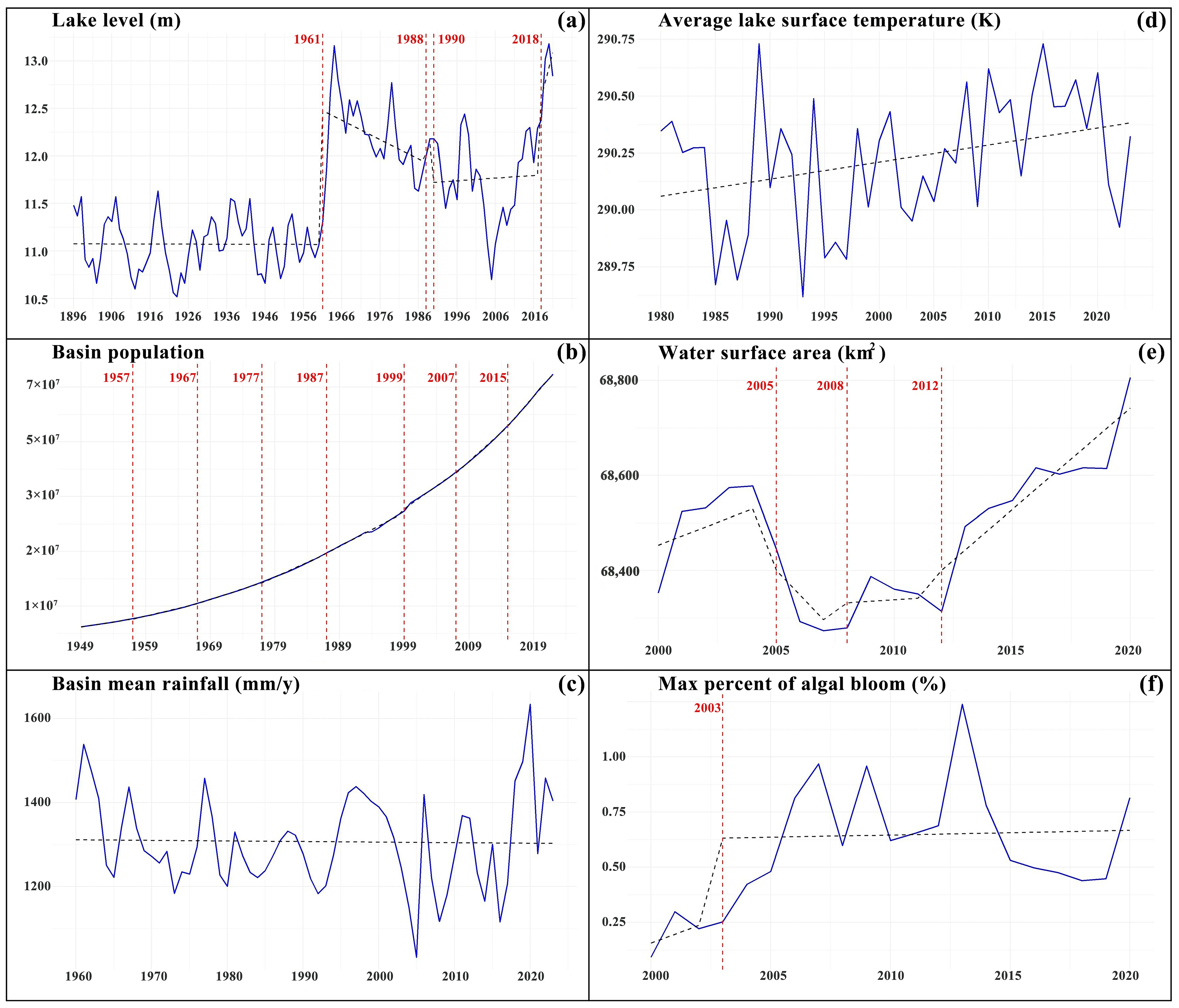
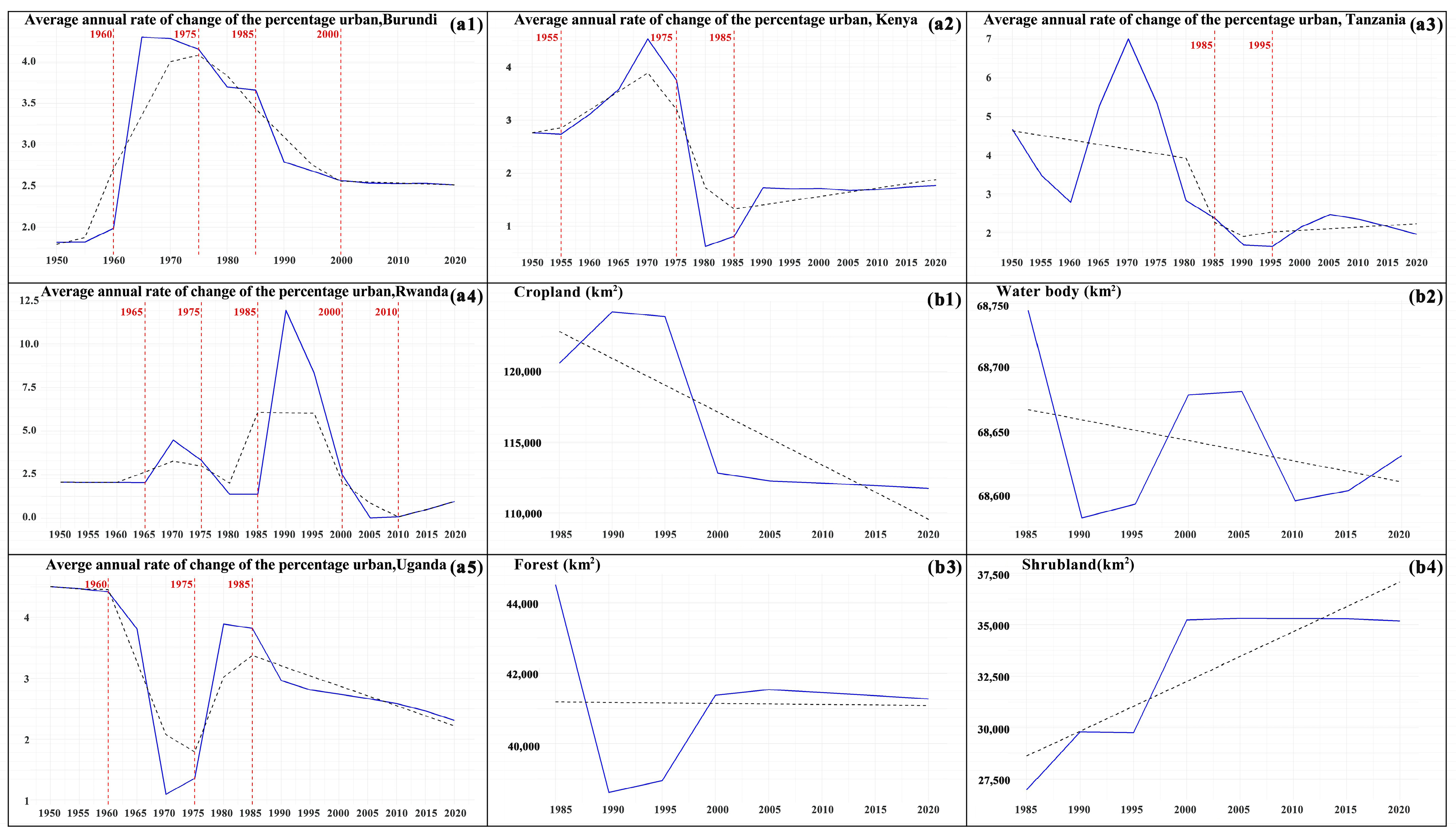
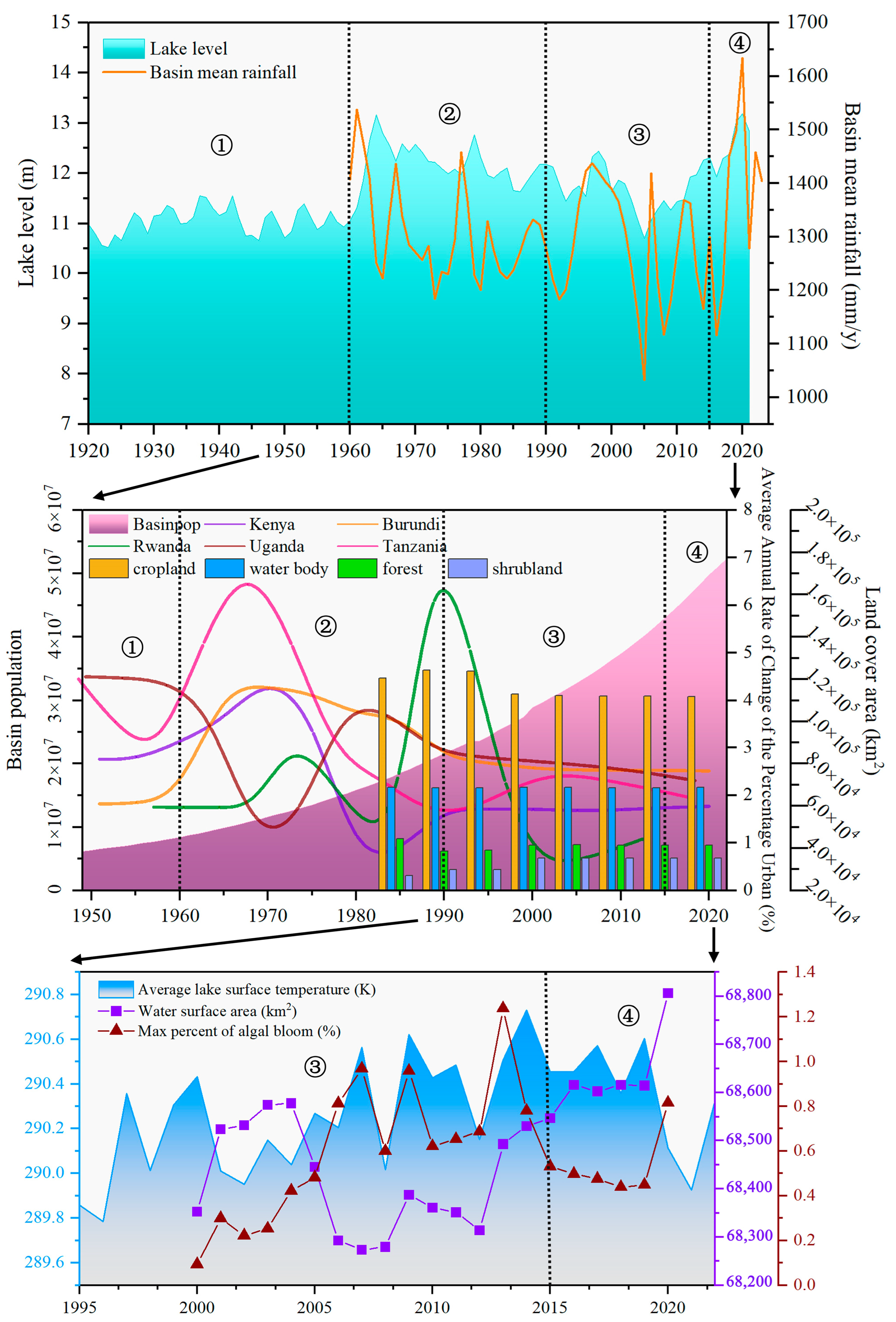


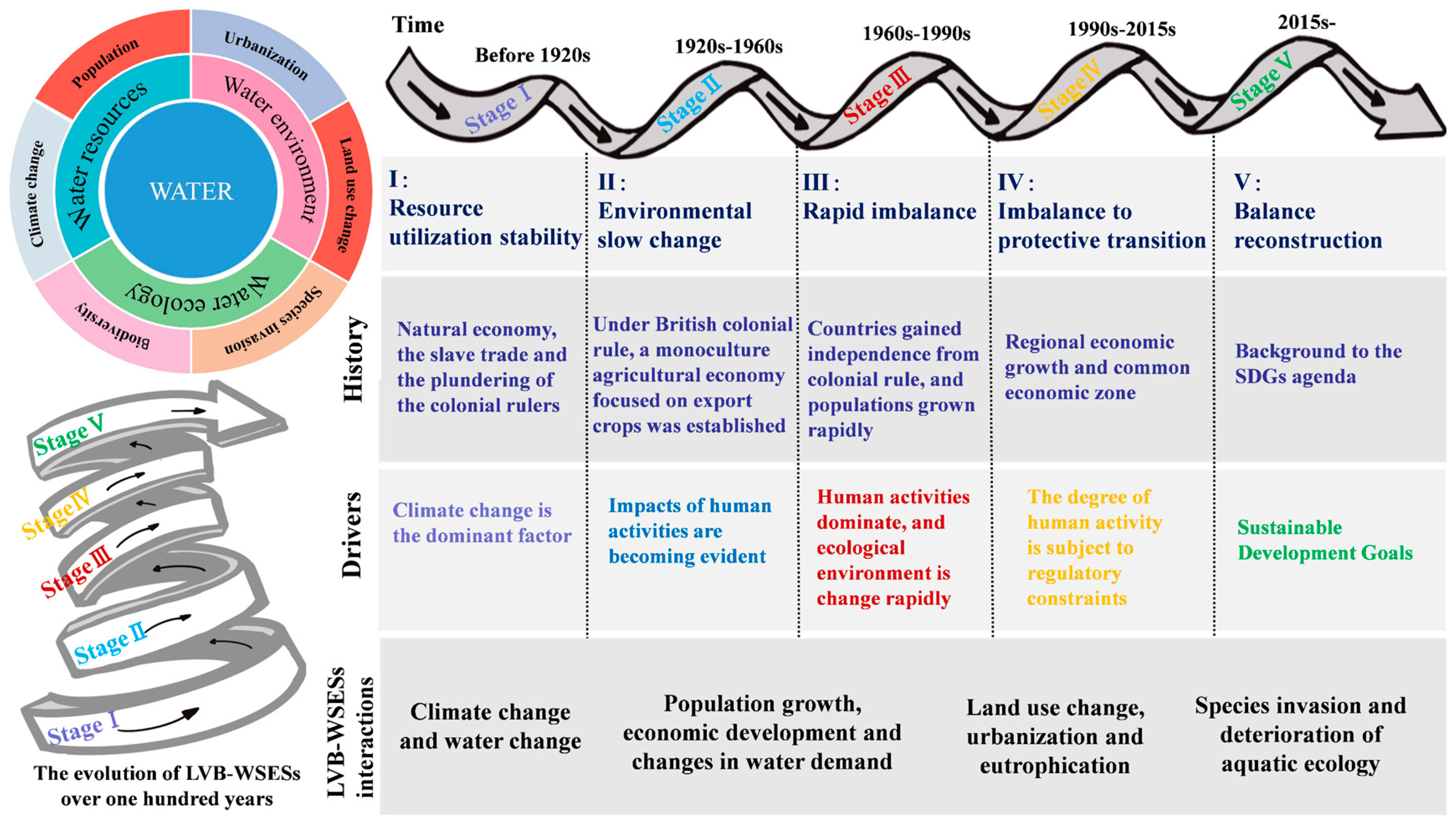
| Category | Subcategories | Data | Acquisition Year | Reference |
|---|---|---|---|---|
| Water system | Water resource | Lake level (m) | 1896–2022 | [33] |
| Lake surface water temperature(K) | 1979–2022 | [34] | ||
| Mean water area (km2) | 2000–2020 | [35] | ||
| Water environment | Maximum algal blooms area | 2000–2020 | [36] | |
| Ecological system | Mean rainfall (mm/year) | 1960–2004 | [28] | |
| Mean rainfall (mm/year) | 2004–2020 | [37] | ||
| Social system | Total population | 1949–2022 | [38,39] | |
| Average annual rate of change in the percentage urban (%) | 1950–2020 | [40] | ||
| Land use and land cover | 1985–2020 | [41] |
Disclaimer/Publisher’s Note: The statements, opinions and data contained in all publications are solely those of the individual author(s) and contributor(s) and not of MDPI and/or the editor(s). MDPI and/or the editor(s) disclaim responsibility for any injury to people or property resulting from any ideas, methods, instructions or products referred to in the content. |
© 2025 by the authors. Licensee MDPI, Basel, Switzerland. This article is an open access article distributed under the terms and conditions of the Creative Commons Attribution (CC BY) license (https://creativecommons.org/licenses/by/4.0/).
Share and Cite
Zhang, X.; Wang, M.; Jin, S.; Kimirei, I.A.; Gao, Q. A Century of Water–Socioecological Dynamics and Evolutionary Stages in Lake Victoria Basin, East Africa. Land 2025, 14, 906. https://doi.org/10.3390/land14040906
Zhang X, Wang M, Jin S, Kimirei IA, Gao Q. A Century of Water–Socioecological Dynamics and Evolutionary Stages in Lake Victoria Basin, East Africa. Land. 2025; 14(4):906. https://doi.org/10.3390/land14040906
Chicago/Turabian StyleZhang, Xinxin, Mengyuan Wang, Shiying Jin, Ismael A. Kimirei, and Qun Gao. 2025. "A Century of Water–Socioecological Dynamics and Evolutionary Stages in Lake Victoria Basin, East Africa" Land 14, no. 4: 906. https://doi.org/10.3390/land14040906
APA StyleZhang, X., Wang, M., Jin, S., Kimirei, I. A., & Gao, Q. (2025). A Century of Water–Socioecological Dynamics and Evolutionary Stages in Lake Victoria Basin, East Africa. Land, 14(4), 906. https://doi.org/10.3390/land14040906









